Kangxi Emperor
| Kangxi Emperor Khang hi đế | |||||||||||||
|---|---|---|---|---|---|---|---|---|---|---|---|---|---|
 | |||||||||||||
| Emperor of the Qing dynasty | |||||||||||||
| Reign | 5 February 1661 – 20 December 1722 | ||||||||||||
| Predecessor | Shunzhi Emperor | ||||||||||||
| Successor | Yongzheng Emperor | ||||||||||||
| Regent | |||||||||||||
| Born | 4 May 1654 Jingren Palace,Forbidden City,Beijing | ||||||||||||
| Died | 20 December 1722(aged 68) Changchun Garden,Imperial Gardens,Beijing | ||||||||||||
| Burial | Jing Mausoleum,Eastern Qing tombs | ||||||||||||
| Spouses | |||||||||||||
| Issue Detail | |||||||||||||
| |||||||||||||
| House | Aisin-Gioro | ||||||||||||
| Dynasty | Qing | ||||||||||||
| Father | Shunzhi Emperor | ||||||||||||
| Mother | Empress Xiaokangzhang | ||||||||||||
| Seal | 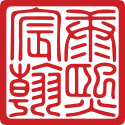 | ||||||||||||
| Kangxi Emperor | |||||||||||||||||||||
|---|---|---|---|---|---|---|---|---|---|---|---|---|---|---|---|---|---|---|---|---|---|
| Chinese name | |||||||||||||||||||||
| Chinese | Khang hiĐế | ||||||||||||||||||||
| |||||||||||||||||||||
| Mongolian name | |||||||||||||||||||||
| Mongolian Cyrillic | Энх амгалан хаан | ||||||||||||||||||||
| Mongolian script | ᠡᠩᠭᠡ ᠠᠮᠤᠭᠤᠯᠠᠩ ᠬᠠᠭᠠ | ||||||||||||||||||||
| |||||||||||||||||||||
| Manchu name | |||||||||||||||||||||
| Manchu script | ᡝᠯᡥᡝ ᡨᠠᡳᡶᡳᠨ ᡥᡡᠸᠠᠩᡩᡳ | ||||||||||||||||||||
| Möllendorff | Elhe Taifin Hūwangdi | ||||||||||||||||||||
TheKangxi Emperor(4 May 1654 – 20 December 1722), also known by histemple nameEmperor Shengzu of Qing,personal nameXuanye,was the fourthemperorof theQing dynasty,and the second Qing emperor to rule overChina proper.His reign of 61 years makes him the longest-reigning emperor inChinese historyand one of thelongest-reigning rulers in history.[1]He is considered one of China's greatest emperors.[2]
The third son of theShunzhi Emperor,Kangxi was enthroned at the age of seven while actual power was held for six more years by theFour Regentsnominated by his father.[3]After assuming personal rule, Kangxi's attempt to revoke the fiefdoms of feudal princes sparked theRevolt of the Three Feudatories,which he suppressed. He also forced theKingdom of Tungningin Taiwan and Mongols in the north and northwest to submit to Qing rule, andlaunched an expeditionthat incorporated Tibet into the empire. Domestically, he initially welcomed theJesuitsand the propagation ofCatholicismin China, but tolerance came to an end as a result of theChinese Rites controversy.Later in his reign, Kangxi became embroiled in a prolonged succession dispute. He died in 1722 at the age of 68 and was succeeded by his fourth son, who assumed the throne as theYongzheng Emperor.
The Kangxi Emperor's reign brought about long-term stability and relative wealth after years of war and chaos. He initiated the period known as theHigh Qing era(or the "Prosperous Era of Kangxi and Qianlong" ),[4]spanning the reigns of the Kangxi Emperor, his son Yongzheng, and his grandsonQianlong.His court also accomplished such literary feats as the compilation of theKangxi Dictionary,theComplete Tang Poemspoetry anthology, and theComplete Classics Collection of Ancient China.
Early reign
[edit]Born on 4 May 1654 to theShunzhi EmperorandEmpress Xiaokangzhangin Jingren Palace, theForbidden City,Beijing,the Kangxi Emperor was originally given the Chinese nameXuanye(Chinese:Huyền diệp;pinyin:Xuanye;Manchu transliteration:hiowan yei). He wasenthronedat the age of seven (or eight byEast Asian age reckoning), on 7 February 1661.[d]However, hisera name"Kangxi", only started to be used on 18February 1662, the first day of the following lunar year.
SinologistHerbert Giles,drawing on contemporary sources, described the Kangxi Emperor as "fairly tall and well proportioned, he loved all manly exercises, and devoted three months annually to hunting. Large bright eyes lighted up his face, which was pitted withsmallpox."[5]

Before the Kangxi Emperor came to the throne,Grand Empress Dowager Zhaosheng(in the name ofShunzhi Emperor) had appointed the powerful menSonin,Suksaha,Ebilun,andOboiasregents.Sonin died after his granddaughter becameEmpress Xiaochengren,leaving Suksaha at odds with Oboi in politics. In a fierce power struggle, Oboi had Suksaha put to death and seized absolute power as sole regent. The Kangxi Emperor and the rest of the imperial court acquiesced to this arrangement.
In the spring of 1662, the regents ordered aGreat Clearancein southern China that evacuated the entire population from the seacoast to counter a resistance movement started byMingloyalists under the leadership of Taiwan-based Ming generalZheng Chenggong,also titledKoxinga.
In 1669, the Kangxi Emperor had Oboi arrested with the help of his grandmotherGrand Empress Dowager Zhaosheng,who had raised him.[6]and began taking personal control of the empire. He listed three issues of concern: flood control of theYellow River;repair of theGrand Canal;theRevolt of the Three Feudatoriesin south China. The Grand Empress Dowager influenced him greatly and he took care of her himself in the months leading up to her death in 1688.[6]
Kangxi's relatives from the Han Chinese Banner Tong đồng clan ofFushuninLiaoningfalsely claimed to be related to theJurchenManchuTunggiyaĐồng giai clan ofJilin,using this false claim to get themselves transferred to a Manchu banner in the reign of Kangxi emperor.[7]
Military achievements
[edit]Army
[edit]
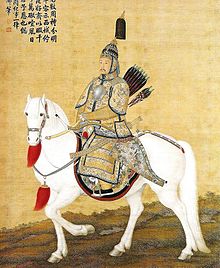
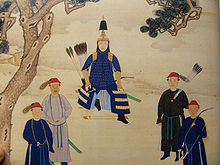
The main army of the Qing Empire, theEight BannersArmy, was in decline under the Kangxi Emperor. It was smaller than it had been at its peak underHong Taijiand in the early reign of theShunzhi Emperor;however, it was larger than in theYongzhengandQianlongemperors' reigns. In addition, theGreen Standard Armywas still powerful with generals such as Tuhai, Fei Yanggu, Zhang Yong, Zhou Peigong,Shi Lang,Mu Zhan, Shun Shike and Wang Jingbao.[citation needed]
The main reason for this decline was a change in system between the Kangxi and Qianlong emperors' reigns. The Kangxi Emperor continued using the traditional military system implemented by his predecessors, which was more efficient and stricter. According to the system, a commander who returned from a battle alone (with all his men dead) would be put to death, and likewise for a foot soldier. This was meant to motivate both commanders and soldiers alike to fight valiantly in war because there was no benefit for the sole survivor in a battle.[citation needed]
By the Qianlong Emperor's reign, military commanders had become lax and the training of the army was deemed less important as compared to during the previous emperors' reigns.
Revolt of the Three Feudatories
[edit]After the Qing takeover of China in 1644, large parts of the south and west were given asfiefsto three Ming generals who aided the Qing; in 1673 the three feudatories were controlled byWu Sangui,Geng Jingzhong,andShang Zhixin.Going against the advice of most of his advisors, Kangxi attempted to force the feudal princes to give up their lands and retire to Manchuria, sparking a rebellion that lasted eight years. For years afterwards Kangxi ruminated on his mistakes and blamed himself in part for the loss of life during the revolt.[8]
Wu Sangui's forces overran most of southwest China and he tried to ally himself with local generals such asWang Fuchen.The Kangxi Emperor employed generals includingZhou PeigongandTuhaito suppress the rebellion, and also granted clemency to common people caught up in the war. He intended to personally lead the armies to crush the rebels but his subjects advised him against it. The Kangxi Emperor used mainly Han ChineseGreen Standard Armysoldiers to crush the rebels while the Manchu Banners took a backseat. The revolt ended with victory for Qing forces in 1681.
Taiwan
[edit]In 1683, the naval forces of the Ming loyalists onTaiwan—organized under theZheng dynastyas theKingdom of Tungning—weredefeated off Penghuby 300-odd ships under theQing admiralShi Lang.Koxinga's grandsonZheng Keshuangsurrendered Tungning a few days later and Taiwan became part of the Qing Empire. Zheng Keshuang moved to Beijing, joined theQing nobilityas the "Duke Haicheng" (Hải trừng công), and was inducted into theEight Bannersas a member of theHanPlain Red Banner.His soldiers—including the rattan-shield troops (Đằng bài doanh,tengpaiying)—were similarly entered into the Eight Banners, notably servingagainst Russian Cossacks at Albazin.
A score of Ming princes had joined the Zheng dynasty on Taiwan, including PrinceZhu Shuguiof Ningjing and Prince Honghuan (Chu hoằng hoàn), the son ofZhu Yihai.The Qing sent most of the 17 Ming princes still living on Taiwan back to mainland China, where they spent the rest of their lives.[9]The Prince of Ningjing and his five concubines, however, committed suicide rather than submit to capture. Their palace was used as Shi Lang's headquarters in 1683, but hememorializedthe emperor to convert it into aMazu templeas a propaganda measure in quieting remaining resistance on Taiwan. The emperor approved its dedication as theGrand Matsu Templethe next year and, honoring the goddessMazufor her supposed assistance during the Qing invasion, promoted her to "Empress of Heaven" (Thiên hậuTianhou) from her previous status as a "heavenly consort" (Thiên phiTianfei).[10][11]Belief in Mazuremains so widespread on Taiwan that her annual celebrations can gather hundreds of thousands of people; she is sometimes evensyncretizedwithGuanyinand theVirgin Mary.
The end of the rebel stronghold and capture of the Ming princes allowed the Kangxi Emperor to relax theSea Banand permit resettlement of theFujianandGuangdongcoasts. The financial and other incentives to new settlers particularly drew theHakka,who would havecontinuous low-level conflictwith the returningPunti peoplefor the next few centuries.
Russia
[edit]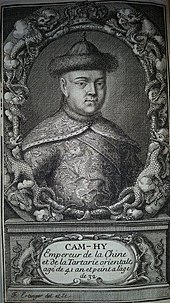
In the 1650s, the Qing Empire engaged theTsardom of Russiain a series ofborder conflictsalong theAmur Riverregion, which concluded with the Qing gaining control of the area after theSiege of Albazin.
The Russians invaded the northern frontier again in the 1680s. A series of battles and negotiations culminated in theTreaty of Nerchinskof 1689, by which a border was agreed between Russia and China.
Mongolia
[edit]The Inner MongolianChaharleaderLigdan Khan,a descendant of Genghis Khan, opposed and fought against the Qing until he died ofsmallpoxin 1634. Thereafter, the Inner Mongols under his sonEjei Khansurrendered to the Qing and he was given the title of Prince (Qin Wang, thân vương ). The Inner Mongolian nobility now became closely tied to the Qing royal family and intermarried with them extensively. Ejei Khan died in 1661 and was succeeded by his brother Abunai. After Abunai showed disaffection with Manchu Qing rule, he was placed under house arrest in 1669 inShenyangand the Kangxi Emperor gave his title to his son Borni.
Abunai bided his time then, with his brother Lubuzung, revolted against the Qing in 1675 during theRevolt of the Three Feudatories,with 3,000 Chahar Mongol followers joining in on the revolt. The revolt was put down within two months, the Qing defeating the rebels in battle on 20 April 1675, killing Abunai and all his followers. Their title was abolished, all Chahar Mongol royal males were executed even if they were born to Manchu Qing princesses, and all Chahar Mongol royal females were sold into slavery except the Manchu Qing princesses. The Chahar Mongols were then put under the direct control of the Qing Emperor unlike the other Inner Mongol leagues which maintained their autonomy.
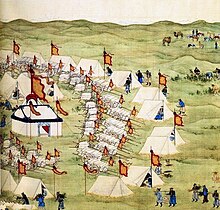
The OuterKhalkha Mongolshad preserved their independence, and only paid tribute to the Qing Empire. However, a conflict between the houses of Jasagtu Khan and Tösheetü Khan led to a dispute between the Khalkha and theDzungarsover the influence ofTibetan Buddhism.In 1688, the Dzungar chief,Galdan Boshugtu Khan,attacked the Khalkha from the west and invaded their territory. The Khalkha royal families and the firstJebtsundamba Khutuktucrossed theGobi Desertand sought help from the Qing Empire in return for submission to Qing authority. In 1690, the Dzungars and Qing forces clashed at theBattle of Ulan ButunginInner Mongolia,in which the Qing eventually emerged as the victor.
In 1696 and 1697 the Kangxi Emperor personally led campaigns against the Dzungars in the earlyDzungar–Qing War.[12]The western section of the Qing army defeated Galdan's forces at theBattle of Jao Modoand Galdan died in the following year.
Manchu Hoifan and Ula rebellion against the Qing
[edit]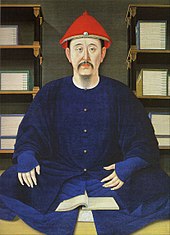
In 1700, some 20,000 QiqiharXibewere resettled inGuisui,modernInner Mongolia,and 36,000 Songyuan Xibe were resettled inShenyang,Liaoning.The relocation of the Xibe from Qiqihar is believed by Liliya M. Gorelova to be linked to the Qing's annihilation of the Manchu clan Hoifan (Hoifa) in 1697 and the Manchu tribe Ula in 1703 after they rebelled against the Qing; both Hoifan and Ula were wiped out.[13]
Tibet
[edit]In 1701, the Kangxi Emperor ordered the reconquest ofKangdingand other border towns in westernSichuanthat had been taken by the Tibetans. The Manchu forcesstormed Dartsedoand secured the border with Tibet and the lucrativetea-horse trade.
The Tibetandesi(regent)Sangye Gyatsoconcealed the death of the5th Dalai Lamain 1682, and only informed the emperor in 1697. He moreover kept relations with Dzungar enemies of the Qing. All this evoked the great displeasure of the Kangxi Emperor. Eventually Sangye Gyatso was toppled and killed by theKhoshutrulerLha-bzang Khanin 1705. As a reward for ridding him of his old enemy theDalai Lama,the Kangxi Emperor appointed Lha-bzang Khan Regent of Tibet (Dực pháp cung thuận hãn;Yìfǎ Gōngshùn Hán;'Buddhism Respecting', ' Deferential Khan').[14]TheDzungar Khanate,a confederation ofOirattribes based in parts of what is nowXinjiang,continued to threaten the Qing Empire and invadedTibetin 1717. They took control ofLhasawith a 6,000 strong army and killed Lha-bzang Khan. The Dzungars held on to the city for three years and at theBattle of the Salween Riverdefeated a Qing army sent to the region in 1718. The Qing did not take control of Lhasa until 1720, when the Kangxi Emperorsent a larger expedition force thereto defeat the Dzungars.
Muslims
[edit]The Kangxi Emperor incited anti-Muslim sentiment among the Mongols ofQinghai(Kokonor) in order to gain support against theDzungarOiratMongol leaderGaldan.Kangxi claimed that Chinese Muslims inside China such asTurkic Muslims in Qinghaiwere plotting withGaldan,who he falsely claimed converted to Islam. Kangxi falsely claimed that Galdan had spurned and turned his back on Buddhism and the Dalai Lama and that he was plotting to install a Muslim as ruler of China after invading it in a conspiracy with Chinese Muslims. Kangxi also distrusted Muslims of Turfan and Hami.[15]
Chinese nobility
[edit]The Kangxi Emperor granted the title of Wujing Boshi (Ngũ kinh bác sĩ;Wǔjīng Bóshì) to the descendants ofShao Yong,Zhu Xi,Zhuansun Shi,Ran family (Ran Qiu,Ran Geng,Ran Yong),Bu Shang,Yan Yan (disciple of Confucius),and theDuke of Zhou's offspring.[16][17]
Economic achievements
[edit]This sectionneeds additional citations forverification.(October 2010) |
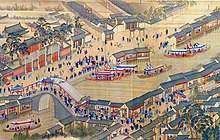
The contents of the national treasury during the Kangxi Emperor's reign were:
- 1668 (7th year of Kangxi): 14,930,000taels
- 1692: 27,385,631 taels
- 1702–1709: approximately 50,000,000 taels with little variation during this period
- 1710: 45,880,000 taels
- 1718: 44,319,033 taels
- 1720: 39,317,103 taels
- 1721 (60th year of Kangxi, second last of his reign): 32,622,421 taels

The reasons for the declining trend in the later years of the Kangxi Emperor's reign were a huge expenditure on military campaigns and an increase in corruption. To fix the problem, the Kangxi Emperor gave Prince Yong (the futureYongzheng Emperor) advice on how to make the economy more efficient.
Cultural achievements
[edit]
During his reign, the Kangxi Emperor ordered the compilation of a dictionary ofChinese characters,which became known as theKangxi Dictionary.This was seen as an attempt by the emperor to gain support from theHan Chinesescholar-bureaucrats,as many of them initially refused to serve him and remained loyal to theMing dynasty.However, by persuading the scholars to work on the dictionary without asking them to formally serve the Qing imperial court, the Kangxi Emperor led them to gradually taking on greater responsibilities until they were assuming the duties of state officials.
In 1700, on the Kangxi Emperor's order, the compilation of a vast encyclopedia known as theComplete Classics Collection of Ancient China(completed during the reign of his successorYongzheng), and a compilation ofTang poetry,theComplete Tang Poems.
The Kangxi Emperor also was interested in Western technology and wanted to import them to China. This was done throughJesuit missionaries,such asFerdinand Verbiest,whom the Kangxi Emperor frequently summoned for meetings, orKarel Slavíček,who made the first precise map ofBeijingon the emperor's order.
From 1711 to 1723,Matteo Ripa,anItalianpriest sent to China by theCongregation for the Evangelization of Peoples,worked as a painter and copper-engraver at the Qing court. In 1723, he returned toNaplesfrom China with four young Chinese Christians, in order to groom them to become priests and send them back to China as missionaries. This marked the beginning of the Collegio dei Cinesi, sanctioned byPope Clement XIIto help the evangelization ofChristianityin China. This Chinese Institute was the first school ofSinologyinEurope,which would later develop to become the Istituto Orientale and the present dayNaples Eastern University.
The Kangxi Emperor was also the first Chinese emperor to play a western musical instrument.Thomas Pereirataught him how to play the harpsichord,[18]and he employedKarel Slavíčekas court musician. Slavíček was playingSpinet;later the emperor would play on it himself. China's famed blue and white porcelain probably reached its zenith during the Kangxi Emperor's reign.
Christianity
[edit]
In the early decades of the Kangxi Emperor's reign,Jesuitsplayed a large role in the imperial court. With their knowledge ofastronomy,they ran the imperial observatory.Jean-François GerbillonandThomas Pereiraserved as translators for the negotiations of theTreaty of Nerchinsk.The Kangxi Emperor was grateful to the Jesuits for their contributions, the many languages they could interpret, and the innovations they offered his military in gun manufacturing[19]andartillery,the latter of which enabled the Qing Empire to conquer theKingdom of Tungning.[20]
The Kangxi Emperor was also fond of the Jesuits' respectful and unobtrusive manner; they spoke theChinese languagewell, and wore the silk robes of the elite.[21]In 1692, when Pereira requested tolerance forChristianity,the Kangxi Emperor was willing to oblige, and issued the Edict of Toleration,[22]which recognizedCatholicism,barred attacks on their churches, and legalized their missions and the practice of Christianity by theChinese people.[23]
However, controversy arose over whether Chinese Christians could still take part in traditionalConfucianceremonies andancestor worship,with the Jesuits arguing for tolerance and theDominicanstaking a hard-line against foreign "idolatry".The Dominican position won the support ofPope Clement XI,who in 1705 sentCharles-Thomas Maillard de Tournonas hisrepresentativeto the Kangxi Emperor, to communicate the ban on Chinese rites.[19][24]Through de Tournon, the Pope insisted on sending his own representative to Beijing to oversee Jesuit missionaries in China. Kangxi refused, wanting to keep missionary activities in China under his final oversight, managed by one of the Jesuits who had been living in Beijing for years.[25]
On 19 March 1715, Pope Clement XI issued thepapal bullEx illa die,which officially condemned Chinese rites.[19]In response, the Kangxi Emperor officially forbade Christian missions in China, as they were "causing trouble".[26]
Succession disputes
[edit]This articleneeds additional citations forverification.(February 2020) |



A prolonged struggle between various princes emerged during the Kangxi Emperor's reign over who should inherit the throne – the Nine Lords' War (Cửu tử đoạt đích).
In 1674 the Kangxi Emperor's first spouse,Empress Xiaochengren,died while giving birth to his second surviving sonYinreng,who at the age of two was namedcrown prince[27]– aHan Chinesecustom, to ensure stability during a time of chaos in the south. Although the Kangxi Emperor left the education of several of his sons to others, he personally oversaw the upbringing of Yinreng, grooming him to be a perfect successor. Yinreng was tutored by themandarinWang Shan, who remained devoted to him, and spent the later years of his life trying to persuade the Kangxi Emperor to restore Yinreng as the crown prince.
Yinreng proved to be unworthy of the succession despite his father showing favoritism towards him. He was said to have beaten and killed his subordinates, and was alleged to have had sexual relations with one of his father's concubines, which was deemedincestand a capital offence. Yinreng also purchased young children fromJiangsuto satisfy hispedophiliacpleasure. In addition, Yinreng's supporters, led bySonggotu,gradually formed a "Crown Prince Party" ( thái tử đảng ), that aimed to help Yinreng get the throne as soon as possible, even if it meant using unlawful methods.
Over the years, the Kangxi Emperor kept constant watch over Yinreng and became aware of his son's many flaws, while their relationship gradually deteriorated. In 1707, the emperor decided that he could no longer tolerate Yinreng's behavior, which he partially mentioned in the imperial edict as "never obeying ancestors' virtues, never obliged to my order, only doing inhumanity and devilry, only showing maliciousness and lust",[28]and decided to strip Yinreng of his position as crown prince. The Kangxi Emperor placed his oldest surviving son,Yinzhi,in charge of overseeing Yinreng'shouse arrest.Yinzhi, an unfavoredShu son,knowing he had no chance of being selected, recommended the eighth prince, Yinsi, and requested his father to order Yinreng's execution. The Kangxi Emperor was enraged and stripped Yinzhi of his titles. The emperor then commanded his subjects to cease debating the succession issue, but despite this and attempts to reduce rumours and speculation as to who the new crown prince might be, the imperial court's daily activities were disrupted. Yinzhi's actions caused the Kangxi Emperor to suspect that Yinreng might have been framed, so he restored Yinreng as crown prince in 1709, with the support of the 4th and 13th princes, and on the excuse that Yinreng had previously acted under the influence of mental illness.

In 1712, during the Kangxi Emperor's last inspection tour of the south, Yinreng, who was put in charge of state affairs during his father's absence, tried to vie for power again with his supporters. He allowed an attempt at forcing the Kangxi Emperor to abdicate when his father returned toBeijing.However, the emperor received news of the plannedcoup d'etat,and was so angry that he deposed Yinreng and placed him under house arrest again. After the incident, the emperor announced that he would not appoint any of his sons as crown prince for the remainder of his reign. He stated that he would place his Imperial Valedictory Will inside a box in thePalace of Heavenly Purity,which would only be opened after his death.
Seeing that Yinreng was completely disavowed, Yinsi and some other princes turned to support the 14th prince, Yinti, while the 13th prince supported Yinzhen. They formed the so-called "Eighth Lord Party" (Bát gia đảng) and "Fourth Lord Party" (Tứ gia đảng).
Death and succession
[edit]Following the deposition of the crown prince, the Kangxi Emperor implemented groundbreaking changes in the political landscape. The 13th prince,Yinxiang,was placed underhouse arrestas well for cooperating withYinreng.The eighth princeYinsiwas stripped of all his titles and only had them restored years later. The 14th princeYinti,whom many considered to be the most likely candidate to succeed the Kangxi Emperor, was sent on a military campaign during the political conflict. Yinsi, along with the ninth and tenth princes,Yintangand Yin'e, pledged their support to Yinti.
In the evening of 20 December 1722, just before his death, the Kangxi Emperor called seven of his sons to assemble at his bedside. They were the third, fourth, eighth, ninth, tenth, sixteenth and seventeenth princes. After the Kangxi Emperor died,Longkodoannounced that the emperor had selected the fourth prince, Yinzhen, as the new emperor. Yinzhen ascended to the throne and became known as theYongzheng Emperor.The Kangxi Emperor was entombed at theEastern TombsinZunhua,Hebei.
A legend concerning the Kangxi Emperor's will states that he choseYintias his heir, but Yinzhen forged the will in his own favour. It has, however, long been refuted by serious historians. Yinzhen, later theYongzheng Emperor,has attracted many rumours, and some novel-like private books claim he did not die of illness but was assassinated by a swordswoman, Lü Siniang (Lữ tứ nương), the granddaughter ofLü Liuliang,though this is never treated seriously by scholars.[30]
Personality and achievements
[edit]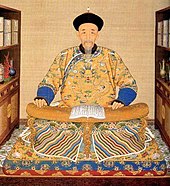
The Kangxi Emperor was a great consolidator of theQing dynasty.The transition from theMing dynastyto the Qing was a cataclysm whose central event was the fall of the capitalBeijingto thepeasant rebelsled byLi Zicheng,then to theManchusin 1644, and the installation of the five-year-oldShunzhi Emperoron their throne. By 1661, when the Shunzhi Emperor died and was succeeded by the Kangxi Emperor, the Qing conquest of China proper was almost complete. Leading Manchus were already using Chinese institutions and masteringConfucianideology, while maintaining Manchu culture among themselves. The Kangxi Emperor completed the conquest, suppressed all significant military threats and revived the central government system inherited from the Ming with important modifications.
The Kangxi Emperor was a workaholic, rising early and retiring late, reading and responding to numerousmemorialsevery day, conferring with his councilors and giving audiences – and this was in normal times; in wartime, he might be reading memorials from the warfront until after midnight or even, as with theDzungarconflict, away on campaign in person.[31]
The Kangxi Emperor devised a system of communication that circumvented thescholar-bureaucrats,who had a tendency to usurp the power of the emperor. ThisPalace Memorial Systeminvolved the transfer of secret messages between him and trusted officials in the provinces, where the messages were contained in locked boxes that only he and the official had access to. This started as a system for receiving uncensored extreme-weather reports, which the emperor regarded as divine comments on his rule. However, it soon evolved into a general-purpose secret "news channel." Out of this emerged aGrand Council,which dealt with extraordinary, especially military, events. The council was chaired by the emperor and manned by his more elevatedHan Chineseand Manchu household staff. From this council, themandarincivil servants were excluded – they were left only with routine administration.[32]
The Kangxi Emperor managed to woo the Confucian intelligentsia into co-operating with the Qing government, despite their deep reservations about Manchu rule and loyalty to the Ming. He appealed to this very sense of Confucian values, for instance, by issuing theSacred Edictin 1670. He encouraged Confucian learning and made sure that thecivil service examinationswere held every three years even during times of stress. When some scholars, out of loyalty to the Ming, refused to take the exams, he hit upon the expedient of a special exam to be taken by nomination. He personally sponsored the writing of theMing Official History,theKangxi Dictionary,a phrase-dictionary, a vast encyclopedia and an even vaster compilation ofChinese literature.To promote his image as a "sage ruler," he appointed Manchu and Chinese tutors with whom he studied the Confucian classics and worked intensively on Chinese calligraphy.[33]
In the one military campaign in which he actively participated, against the Dzungar Mongols, the Kangxi Emperor showed himself an effective military commander. According to Finer, the emperor's own written reflections allow one to experience "how intimate and caring was his communion with the rank-and-file, how discriminating and yet masterful his relationship with his generals".[34]
As a result of the scaling down of hostilities as peace returned to China after the Manchu conquest, and also as a result of the ensuing rapid increase of population, land cultivation and therefore tax revenues based on agriculture, the Kangxi Emperor was able first to make tax remissions, then in 1712 to freeze theland taxandcorvéealtogether, without embarrassing the state treasury (although the dynasty eventually suffered from this fiscal policy, as this preserved tax rates in perpetuity, preventing later emperors from adjusting the fiscal system and hindering attempts at modernisation).[35][36]
Family
[edit]Empress
[edit]- Empress Xiaochengren( hiếu thành nhân hoàng hậu ) of theHešeri clan( hách xá lí thị; 3 February 1654 – 6 June 1674)
- Chenghu( thừa hỗ; 4 January 1670 – 3 March 1672), second son
- Yunreng( duẫn nhưng ),PrinceLimiof the First Rank( lý mật thân vương; 6 June 1674 – 27 January 1725), seventh (second) son
- Empress Xiaozhaoren( hiếu chiêu nhân hoàng hậu ) of theNiohuru clan( nữu hỗ lộc thị; 1653 – 18 March 1678)[e]
- Empress Xiaoyiren( hiếu ý nhân hoàng hậu ) of theTunggiya clan( đồng giai thị;? – 24 August 1689)[f]
- Eighth daughter(13 July 1683 – 6 August 1683)
- Miscarriage(August 1689)
- Empress Xiaogongren( hiếu cung nhân hoàng hậu ) of theUya clan( ô nhã thị; 28 April 1660 – 25 June 1723)
- Yinzhen( dận chân ), theYongzheng Emperor( ung chính đế; 13 December 1678 – 8 October 1735), 11th (fourth) son
- Yinzuo( dận tộ; 5 March 1680 – 15 June 1685), 14th (sixth) son
- Seventh daughter(5 July 1682 – September 1682)
- PrincessWenxianof the First Rank ( cố luân ôn hiến công chủ; 10 November 1683 – August/September 1702), ninth daughter
- Married Shun'anyan ( thuấn an nhan;? – 1724) of the ManchuTunggiya clanin October/November 1700
- 12th daughter(14 June 1686 – February/March 1697)
- Yunti( duẫn đề ),PrinceXunqinof the Second Rank( tuân cần quận vương; 10 February 1688 – 16 February 1755), 23rd (14th) son
Imperial Noble Consort
[edit]- Imperial Noble Consort Quehui( khác huệ hoàng quý phi ) of theTunggiya clan( đồng giai thị; September/October 1668 – 24 April 1743)[g]
- Imperial Noble Consort Jingmin( kính mẫn hoàng quý phi ) of the Janggiya clan ( chương giai thị;? – 20 August 1699)
- Yinxiang( dận tường ),PrinceYixianof the First Rank( di hiền thân vương; 16 November 1686 – 18 June 1730), 22nd (13th) son
- PrincessWenkeof the Second Rank ( hòa thạc ôn khác công chủ; 31 December 1687 – 27 July 1709), 13th daughter
- Married Cangjin ( thương tân ) of the Mongol OnnigudBorjigin clanin August/September 1706
- PrincessDunkeof the Second Rank ( hòa thạc đôn khác công chủ; 3 February 1691 – 2 January 1710), 15th daughter
- Married Dorji ( đa nhĩ tế;? – 1720) of the MongolKhorchinBorjigin clanin January/February 1709 and had issue (one daughter)
- Imperial Noble Consort Dunyi( đôn di hoàng quý phi ) of theGūwalgiya clan( qua nhĩ giai thị; 3 December 1683 – 30 April 1768)
- 18th daughter(17 November 1701 – November 1701)
Noble Consort
[edit]- Noble Consort Wenxi( ôn hi quý phi ) of theNiohuru clan( nữu hỗ lộc thị; 14 February 1661 – 19 December 1694)[h]
- Yun'e( duẫn nga ), Duke of the Second Rank ( phụ quốc công; 28 November 1683 – 18 October 1741), 18th (10th) son
- 11th daughter(24 October 1685 – June/July 1686)
Consort
[edit]- Consort Hui( tuệ phi ) of theKhorchinBorjigin clan( bác nhĩ tế cát đặc thị;? – 30 May 1670)[i]
- Consort Hui( huệ phi ) of theUla-Nara clan( diệp hách na lạp thị;? – 1 May 1732)
- Chengqing( thừa khánh; 21 March 1670 – 26 May 1671), third son
- Yunzhi( duẫn thì ), Prince of the Fourth Rank ( bối tử; 12 March 1672 – 7 January 1735), fifth (first) son
- Consort Yi( nghi phi ) of theGorolo clan( quách lạc la thị; 1660 – 2 October 1733), personal name wasNalanzhu( nạp lan châu )
- Yunki( duẫn kỳ ),PrinceHengwenof the First Rank( hằng ôn thân vương; 5 January 1680 – 10 July 1732), 13th (fifth) son
- Yuntang( duẫn đường ), Prince of the Fourth Rank ( bối tử; 17 October 1683 – 22 September 1726), 17th (ninth) son
- Yinzi( dận tư; 8 June 1685 – 22 August 1696), 20th (11th) son
- Consort Rong( vinh phi ) of theMagiya clan( mã giai thị;? – 26 April 1727)
- Chengrui( thừa thụy; 5 November 1667 – 10 July 1670), first son
- Saiyinchahun( tái âm sát hồn; 24 January 1672 – 6 March 1674), fourth son
- PrincessRongxianof the First Rank( cố luân vinh hiến công chủ; 20 June 1673 – 29 May 1728), third daughter
- Married Örgen ( ô nhĩ cổn;? – 1721) of the Mongol BarinBorjigin clanin June/July 1691 and had issue (a son)
- Changhua( trường hoa; 11 May 1674 –?), sixth son
- Changsheng( trường sinh; 10 September 1675 – 27 April 1677), eighth son
- Yunzhi( duẫn chỉ ),PrinceChengyinof the Second Rank( thành ẩn quận vương; 23 March 1677 – 10 July 1732), 10th (third) son
- Consort Ping( bình phi ) of theHešeri clan( hách xá lí thị;? – 18 July 1696)
- Yinji( dận ky; 23 February 1691 – 30 March 1691), 24th son
- Consort Liang( lương phi ) of the Wei clan ( vệ thị; 1662 – 29 December 1711)
- Yunsi( duẫn tự ), PrinceLianof the First Rank ( liêm thân vương; 29 March 1681 – 5 October 1726), 16th (eighth) son
- Consort Xuan( tuyên phi ) of theKhorchinBorjigin clan( bác nhĩ tế cát đặc thị;? – 12 September 1736), personal nameChenglian( thành liên )[j]
- Consort Cheng( thành phi ) of the Daigiya clan ( đái giai thị;? – 18 December 1740)
- Yunyou( duẫn hữu ),PrinceChunduof the First Rank( thuần độ thân vương; 19 August 1680 – 18 May 1730), 15th (seventh) son
- Consort Shunyimi( thuận ý mật phi ) of the Wang clan ( vương thị;? – 19 November 1744)
- Yunxu( duẫn ngô ),PrinceYukeof the Second Rank( du khác quận vương; 24 December 1693 – 8 March 1731), 25th (15th) son
- Yunlu( duẫn lộc ),PrinceZhuangkeof the First Rank( trang khác thân vương; 28 July 1695 – 20 March 1767), 26th (16th) son
- Yinxie( dận giới; 15 May 1701 – 17 October 1708), 28th (18th) son
- Consort Chunyuqin( thuần dụ cần phi ) of the Chen clan ( trần thị;? – 12 January 1754)
- Yunli( duẫn lễ ),PrinceGuoyiof the First Rank( quả nghị thân vương; 24 March 1697 – 21 March 1738), 27th (17th) son
- Consort Ding( định phi ) of the Wanlioha clan ( vạn lưu cáp thị; January/February 1661 – 24 May 1757)
- Yuntao( duẫn đào ),PrinceLüyiof the First Rank( lí ý thân vương; 18 January 1686 – 1 September 1763), 21st (12th) son
Concubine
[edit]- Concubine An( an tần ) of the Li clan ( lý thị )
- Concubine Jing( kính tần ) of theWanggiya clan( vương giai thị )
- Concubine Duan( đoan tần ) of the Dong clan ( đổng thị;? – 1702)
- Second daughter(17 April 1671 – March/April 1673)
- Concubine Xi( hi tần ) of theHešeri clan( hách xá lí thị;? – 31 October 1702)
- Concubine Tong( thông tần ) of theUla-Nara clan( na lạp thị; 1664 – 1 August 1744)
- PrincessChunqueof the First Rank ( cố luân thuần khác công chủ; 20 March 1685 – 22 April 1710), 10th daughter
- Married Ts'ering ( sách lăng;? – 1750) of the MongolKhalkhaBorjigin clanin June/July 1706 and had issue (one son)
- PrincessChunqueof the First Rank ( cố luân thuần khác công chủ; 20 March 1685 – 22 April 1710), 10th daughter
- Concubine Xiang( tương tần ) of the Gao clan ( cao thị;? – 14 August 1746), personal nameZaiyi( tại nghi )
- Yinji( dận cát; 25 October 1702 – 28 March 1704), 29th (19th) son
- 19th daughter(30 March 1703 – February/March 1705)
- Yunyi( duẫn y ), PrinceJianjingof the Third Rank ( giản tĩnh bối lặc; 1 September 1706 – 30 June 1755), 30th (20th) son
- Concubine Jin( cẩn tần ) of the Sehetu clan ( sắc hách đồ thị; 2 August 1682 – 23 April 1739)
- Yunhu( duẫn hỗ ), PrinceGongqinof the Third Rank ( cung cần bối lặc; 10 January 1712 – 12 February 1744), 32nd (22nd) son
- Concubine Jing( tĩnh tần ) of the Shi clan ( thạch thị; 13 December 1689 – 10 July 1758)
- Yunci( duẫn kỳ ), PrinceChengof the Third Rank ( thành bối lặc; 14 January 1714 – 31 August 1785), 33rd (23rd) son
- Concubine Xi( hi tần ) of the Chen clan ( trần thị; April/May 1690 – 1 February 1737)
- Yunxi( duẫn hi ),PrinceShenjingof the Second Rank( thận tĩnh quận vương; 27 February 1711 – 26 June 1758), 31st (21st) son
- Concubine Mu( mục tần ) of the Chen clan ( trần thị;? – 1727)
- Yunbi( duẫn bí ),PrinceXiankeof the First Rank(𫍯 khác thân vương; 5 July 1716 – 3 December 1773), 34th (24th) son
- Yinyuan( dận viên; 2 March 1718), 35th son
Noble Lady
[edit]- Noble Lady Yi( y quý nhân ) of the Yi clan ( dịch thị;? – 1728)
- Noble Lady Bu( bố quý nhân ) of theJoogiya clan( triệu giai thị;? – 21 February 1717)
- PrincessDuanjingof the Second Rank ( hòa thạc đoan tĩnh công chủ; 9 June 1674 – March/April 1710), fifth daughter
- Married Ga'erzang ( cát nhĩ tang; 1675–1722) of the MongolKharchinUlanghan clan in November/December 1692, and had issue (one daughter)
- PrincessDuanjingof the Second Rank ( hòa thạc đoan tĩnh công chủ; 9 June 1674 – March/April 1710), fifth daughter
- Noble Lady( quý nhân ) of theNara clan( na lạp thị )
- Wanfu( vạn phủ; 4 December 1675 – 11 March 1679), ninth son
- Yinzan( dận tán; 10 April 1679 – 30 April 1680), 12th son
- Noble Lady( quý nhân ) of theGorolo clan( quách lạc la thị ), personal name wasBuyinzhu( bố âm châu )
- PrincessKejingof the First Rank ( cố luân khác tĩnh công chủ; 4 July 1679 – March/April 1735), sixth daughter
- Married Dondob Dorji ( đôn đa bố đa nhĩ tế;? – 1743) of the MongolKhalkhaBorjigin clanin December 1697/January 1698 and had issue (three sons)
- Yinju( dận vũ; 13 September 1683 – 17 July 1684), 19th son
- PrincessKejingof the First Rank ( cố luân khác tĩnh công chủ; 4 July 1679 – March/April 1735), sixth daughter
- Noble Lady( quý nhân ) of the Yuan clan ( viên thị;? – 25 September 1719)
- PrincessQuejingof the Second Rank ( hòa thạc khác tĩnh công chủ; 16 January 1690 – 1736), 14th daughter
- Married Sun Chengyun ( tôn thừa vận;? – 1719) in 1706
- PrincessQuejingof the Second Rank ( hòa thạc khác tĩnh công chủ; 16 January 1690 – 1736), 14th daughter
Mistress
[edit]- Mistress( cách cách ) of the Zhang clan ( trương thị )
- First daughter(23 December 1668 – November 1671)
- Fourth daughter(16 March 1674 – January/February 1679)
- Mistress( cách cách ) of the Wang clan ( vương thị )
- 16th daughter(27 November 1695 – October/November 1707)
- Mistress( cách cách ) of the Liu clan ( lưu thị )
- 17th daughter(12 January 1699 – December 1700 or January 1701)
- Mistress( cách cách ) of theNiohuru clan( nữu hỗ lộc thị )
- 20th daughter(20 November 1708 – January/February 1709)
Ancestry
[edit]| Nurhaci(1559–1626) | |||||||||||||||
| Hong Taiji(1592–1643) | |||||||||||||||
| Empress Xiaocigao(1575–1603) | |||||||||||||||
| Shunzhi Emperor(1638–1661) | |||||||||||||||
| Jaisang | |||||||||||||||
| Empress Xiaozhuangwen(1613–1688) | |||||||||||||||
| Boli (d. 1654) | |||||||||||||||
| Kangxi Emperor (1654–1722) | |||||||||||||||
| Yangzhen (d. 1621) | |||||||||||||||
| Tulai (1606–1658) | |||||||||||||||
| Empress Xiaokangzhang(1638–1663) | |||||||||||||||
| Lady Gioro | |||||||||||||||
In popular culture
[edit]Fiction
[edit]- The Great Kangxi Emperor(Khang hi đại đế), ahistorical novelbyEryue Hewhich romanticises the Kangxi Emperor's life.[37]
- The Deer and the Cauldron,awuxianovel byJin Yong.In the novel, the Kangxi Emperor and the protagonist,Wei Xiaobao,become close friends in their childhood. Wei Xiaobao helps the emperor consolidate his rule over the Qing Empire and plays an important role in how significant historical events of the Kangxi era unfold.[38]
- Seven Swords Descend from Mount Heaven,a wuxia novel byLiang Yusheng.In the novel, the Kangxi Emperor discovers that his father, theShunzhi Emperor,has become a monk in a monastery onMount Wutai.He orders a close aide to kill his father in order to consolidate power, and later attempts to erase evidence of the murder.[39]
Film and television
[edit]| Year | Region | Title | Type | Kangxi Emperor actor | Notes |
|---|---|---|---|---|---|
| 1984 | Hong Kong | The Deer and the Cauldron | Television | Andy Lau | A Hong Kong television series adapted fromThe Deer and the Cauldron |
| 1995 | Hong Kong | The Ching Emperor( thiên tử đồ long ) | Television | Julian Cheung | TVB series |
| 1998 | Hong Kong | The Deer and the Cauldron | Television | Steven Ma | Hong Kong television series adapted fromThe Deer and the Cauldron |
| 2000 | Hong Kong/Taiwan | The Duke of Mount Deer( tiểu bảo dữ khang hi ) | Television | Patrick Tam | Adapted fromLouis Cha's novelThe Deer and the Cauldron. |
| 2001 | Mainland China | Kangxi Dynasty | Television | Chen Daoming | Adapted from Eryue He's novelThe Great Kangxi Emperor |
| 2006 | Mainland China | Secret History of Kangxi( khang hi bí sử ) | Television | Xia Yu | The fourth instalment in a four-part Chinese television series about the early history of theQing dynasty |
| 1998–2007 | Mainland China | Records of Kangxi's Travel Incognito | Television | Zhang Guoli | A five-season Chinese television series about the Kangxi Emperor's inspection tours to southern China. During some of his tours, the emperor disguised himself as a commoner to conceal his identity so that he can blend into society and understand commoners' daily lives better. |
| 2008 | Mainland China | The Deer and the Cauldron | Television | Wallace Chung | Chinese television series adapted fromThe Deer and the Cauldron |
| 2011 | Mainland China | Palace | Television | Kent Tong | Chinese television series set in the Kangxi era of the Qing dynasty. A woman from the 21st century accidentally travels back in time to the 18th century. |
| Hong Kong | The Life and Times of a Sentinel | Television | Power Chan | Hong Kong television series aboutFuquanattempting to overthrow the Kangxi Emperor | |
| Mainland China | Scarlet Heart | Television | Damian Lau | Chinese television series set in the Kangxi era of the Qing dynasty. A woman from the 21st century accidentally travels back in time to the 18th century. | |
| 2013 | Mainland China | The Palace | Film | Winston Chao | |
| 2014 | Mainland China | The Deer and the Cauldron | Television | Wei Qianxiang | Chinese television series adapted fromThe Deer and the Cauldron |
| 2014 | Hong Kong | Gilded Chopsticks | Television | Elliot Ngok | Hong Kong television series about a chef who befriends Yinzhen (the future Yongzheng Emperor) and aids him in the power struggle for the succession. |
| 2016 | Mainland China | Chronicle of Life | Television | Hawick Lau | Chinese television series about a romance between the Kangxi Emperor and his childhood love. |
| 2017 | Mainland China | Legend of Dragon Pearl | Television | Qin Junjie | Chinese television series about Kangxi at the beginning of his reign. |
| 2019 | Mainland China | Dreaming Back to the Qing Dynasty[40] | Television | Liu Jun | |
| 2022 | Mainland China | The Long River | Television | Luo Jin | Chinese television series about Kangxi's efforts to recruit talented officials to manage the Yellow River. |
Video games
[edit]- Age of Empires III: The Asian Dynasties:The Kangxi Emperor is featured as the Chinese leader in thisreal-time strategygame.
- Call Me Emperor:Kangxi is featured as a minister in thisStrategy Click-RPGgame.
See also
[edit]Notes
[edit]- ^Huyền diệp;Manchu:Hiowan yeiᡥᡳᠣᠸᠠᠨ ᠶᡝᡳ
- ^Khang hi;Manchu:Elhe taifinᡝᠯᡥᡝ ᡨᠠᡳᡶᡳᠨ;Mongolian:Энх амгаланᠡᠩᠬᠡ ᠠᠮᠤᠭᠤᠯᠠᠩ
- ^Thánh tổ;Manchu:Šengdzuᡧᡝᠩᡯᡠ
- ^Note that Xuanye was born in May 1654, and was therefore less than seven years old at the time. BothSpence 2002andOxnam 1975(p. 1) nonetheless claim that he was "seven years old."Dennerline 2002(p. 119) andRawski 1998(p. 99) indicate that he was "not yet seven years old." FollowingEast Asian age reckoning,Chinese documents concerning the succession say that Xuanye was eightsui(Oxnam 1975,p. 62).
- ^The Kangxi Emperor's second cousin and elder sister ofNoble Consort Wenxi.
- ^The Kangxi Emperor's first cousin and elder sister ofImperial Noble Consort Quehui.
- ^The Kangxi Emperor's first cousin and younger sister ofEmpress Xiaoyiren.
- ^The Kangxi Emperor's second cousin and younger sister ofEmpress Xiaozhaoren.
- ^The Kangxi Emperor's first cousin-twice-removed.
- ^The Kangxi Emperor's third cousin.
References
[edit]- ^"Emperor Kangxi - The Emperor Who Reigned for the Longest Period in Chinese History".Cultural China. Archived fromthe originalon 21 March 2013.Retrieved21 March2013.
- ^Magill, Frank N.; Taylor, Larissa Juliet, eds. (2006).Great lives from history(First ed.). Pasadena, CA: Salem.ISBN978-1-587-65222-6.
- ^"NOVEMBER 9, 2018 BY - The Kangxi Emperor".Columbia University. 9 November 2018.
- ^Rowe (2009),p. 63.
- ^Giles 1912,p. 40.
- ^abPeterson, Bennet.Notable Women of China.p. 328.
- ^Crossley, Pamela (June 1983)."restricted access The Tong in Two Worlds: Cultural Identities in Liaodong and Nurgan during the 13th-17th centuries".Ch'ing-shih Wen-t'i.4(9). Johns Hopkins University Press: 21–46.
- ^Spence, Jonathan D. (1974).Emperor of China: Self-portrait of Kʻang-hsi(Vintage books ed.). New York. pp. xvi–xvii, 36–38.ISBN0-679-72074-X.OCLC18931977.
{{cite book}}:CS1 maint: location missing publisher (link) - ^Manthorpe 2008,p. 108.
- ^Bergman, Karl (2009),"Tainan Grand Matsu Temple",Tainan City Guide,Tainan: Word Press.
- ^"Tainan Grand Matsu Temple",Chinatownology,2015.
- ^Spence 1974, p. xv.
- ^Gorelova 2002,p. 36.
- ^Cordier & Pelliot 1922,p. 33.
- ^Perdue, Peter C (2009).China Marches West: The Qing Conquest of Central Eurasia(reprint ed.). Harvard University Press. pp. 191, 192.ISBN978-0674042025.
- ^Bất tường (21 August 2015).Tân thanh sử.Sóc tuyết hàn. GGKEY:ZFQWEX019E4.
- ^H.S. Brunnert; V.V. Hagelstrom (15 April 2013).Present Day Political Organization of China.Routledge. pp. 493–494.ISBN978-1-135-79795-9.
- ^Spence 1974, p. 73.
- ^abcMantienne, p. 180
- ^Les Missions Etrangeres,p. 83
- ^Manteigne, p. 178
- ^"In the Light and Shadow of an Emperor: Tomás Pereira, S.J. (1645–1708), the Kangxi Emperor and the Jesuit Mission in China",An International Symposium in Commemoration of the 3rd Centenary of the death of Tomás Pereira, S.J.,Lisbon, Portugal and Macau, China, 2008, archived fromthe originalon 22 August 2009
{{citation}}:CS1 maint: location missing publisher (link) - ^Neill, S. (1964).A History of Christian Missions,Harmondsworth: Penguin Books, pp. 189-190.
- ^Aldridge, Alfred Owen,Masayuki Akiyama, Yiu-Nam Leung.Crosscurrents in the Literatures of Asia and the West,p. 54[1]
- ^Spence 1974, pp. xviii-xix, 76-79.
- ^Li, Dan J., trans. (1969).China in Transition, 1517–1911,New York: Van Nostrand Reinhold Company, p. 22
- ^Spence 1974, p. 120.
- ^original words: Bất pháp tổ đức, bất tuân trẫm huấn, duy tứ ác ngược chúng, bạo lệ dâm loạn
- ^Minh hiếu lăng lưỡng đại “Bi thạch chi mê” bị phá giảiArchived18 October 2012 at theWayback Machine(Solving the two great riddles of the Ming Xiaoling's stone tablets).People's Daily,13 June 2003. Quote regarding the Kangxi Emperor's stele text and its meaning: "Thanh triều hoàng đế cung tự minh triều hoàng đế... Ngự thư “Trị long đường tống” ( ý tư thị tán dương chu nguyên chương đích công tích siêu quá liễu đường thái tông lý thế dân, tống cao tổ triệu khuông dận ) "
- ^Lữ tứ nương thứ ung chính chỉ thị cá truyện thuyếtArchived21 February 2014 atarchive.today
- ^Finer (1997), pp. 1134–5
- ^Spence,The Search for Modern China(2013), pp. 67-68
- ^Spence,The Search for Modern China(2013), pp. 56-58.
- ^Finer (1997), p. 1142.
- ^Finer (1997), pp. 1156–7.
- ^Hammond, Kenneth J. (2004).From Yao to Mao: 5000 Years of Chinese History Part III(PDF).pp. 7–8.
- ^Eryue He(2018).Kangxi Emperor(in Chinese). Trường giang văn nghệ xuất bản xã.ISBN978-7535468987.
- ^Cha, Louis(2018). Minford, John (ed.).The Deer and the Cauldron:3 Volume Set.Oxford, United Kingdom: Oxford University Press.ISBN978-0190836054.
- ^Liang, Yusheng(1956).Qijian Xia Tianshan(in Chinese). China: Guangdong Travel and Tourism Press.ISBN9787805216461.
- ^Võng dịch (23 January 2019)."《 mộng hồi đại thanh 》 chủ diễn trận dung tân tiên xuất lô chúng chủ diễn nhan trị bạo biểu".ent.163.com.Retrieved1 March2019.
Bibliography and further reading
[edit]- Cordier, Henri; Pelliot, Paul, eds. (1922).T'oung Pao ( thông báo ) or Archives.Vol. XX1. Leiden: E.J. Brill.
- Dennerline, Jerry (2002),"The Shun-chih Reign",in Peterson, Willard J. (ed.),Cambridge History of China, Vol. 9, Part 1: The Ch'ing Dynasty to 1800,Cambridge: Cambridge University Press, pp. 73–119,ISBN0-521-24334-3.
- Finer, S. E. (1997).The History of Government from the Earliest Times.ISBN0-19-822904-6(three-volume set, hardback)
- Bennet Peterson, Barbara (2000).Notable Women of China: Shang Dynasty to the Early Twentieth Century.M.E. Sharpe, Inc.
- Giles, Herbert(1912),China and the Manchus,Cambridge UK: Cambridge University Press
- Gorelova, Liliya M., ed. (2002).Handbook of Oriental Studies. Section 8 Uralic & Central Asian Studies, Manchu Grammar.Vol. Seven Manchu Grammar. Brill Academic Pub.ISBN9004123075.Retrieved6 May2014.
- Oxnam, Robert B.(1975),Ruling from Horseback: Manchu Politics in the Oboi Regency, 1661–1669,Chicago and London: University of Chicago Press,ISBN0-226-64244-5.
- Rawski, Evelyn S. (1998),The Last Emperors: A Social History of Qing Imperial Institutions,Berkeley, Los Angeles, and London: University of California Press,ISBN0-520-22837-5.
- Rowe, William T. (2009).China's Last Empire: The Great Qing.Cambridge, MA: Harvard University Press.ISBN9780674036123.
- Spence, Jonathan D.(2002),"The K'ang-hsi Reign",in Peterson, Willard J. (ed.),Cambridge History of China, Vol. 9, Part 1: The Ch'ing Dynasty to 1800,Cambridge, England: Cambridge University Press, pp. 120–82,ISBN0-521-24334-3.
- Kangxi and Jonathan D. Spence (1975).Emperor of China: Self Portrait of K'ang Hsi.New York: Vintage Books.ISBN0394714113.
- Ch. 3, "Kangxi's Consolidation," inJonathan D. Spence,The Search for Modern China(New York: Norton; 3rd, 2013), pp. 48–71.
- Zhao, Gang (January 2006). "Reinventing China Imperial Qing Ideology and the Rise of Modern Chinese National Identity in the Early Twentieth Century".Modern China.32(1). Sage Publications: 3–30.doi:10.1177/0097700405282349.JSTOR20062627.S2CID144587815.
- Hummel, Arthur W. Sr.,ed. (1943)..Eminent Chinese of the Ch'ing Period.United States Government Printing Office.
External links
[edit] Media related toKangxi Emperorat Wikimedia Commons
Media related toKangxi Emperorat Wikimedia Commons

